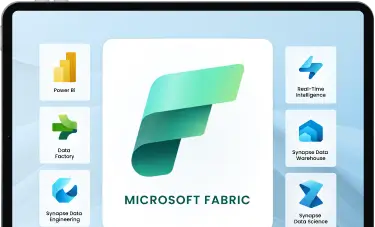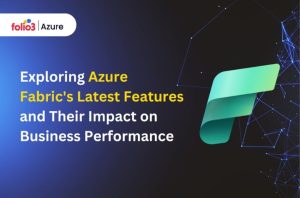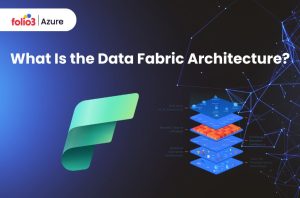Table of Contents
ToggleEnterprises today are increasingly focused on harnessing the potential of big data and advanced analytics to gain insights that can drive business strategy. In this data-driven era, Microsoft Fabric, an all-encompassing platform, is reshaping the way organizations collect, manage, and analyze data. In this extensive guide, we will explore the intricate details of Microsoft Fabric, shedding light on its features, benefits, and numerous use-cases.
Understanding Microsoft Fabric in the Data Analytics Landscape
At the forefront of Microsoft’s offerings in the data and analytics domain stands the robust Microsoft Fabric. A platform that empowers organizations to make data-driven decisions, Microsoft Fabric is designed to handle the end-to-end data lifecycle, from data ingestion to insights consumption.
Marrying the twin pillars of Microsoft’s strength, Azure and Artificial Intelligence, Microsoft Fabric is not just a data platform but a comprehensive solution for businesses across all sectors. By leveraging Microsoft Fabric, enterprises can unlock the full potential of their data streams, impacting operational efficiency, risk management, and customer experience.
Why Microsoft Fabric is a Game-Changer?
The emergence of Fabric is not simply an enhancement to Microsoft’s existing analytics suite. Instead, it represents a fundamental shift in approach from the tech giant, one that places Lake-centric paradigms at the core of data management.
In simple terms, Fabric represents Microsoft’s commitment to a standardized but open architecture that is agnostic to types and sources. By adopting Microsoft Fabric, enterprises free themselves from the constraints of complex proprietary systems, fostering an environment where diversity of data is celebrated.
The Core Features of Microsoft Fabric
Microsoft Fabric is a multifaceted platform, and to fully appreciate its value, it is crucial to understand its core features, which include:
1. Complete Analytics Platform
At the heart of Microsoft Fabric is its capability to deliver a fully managed analytics platform. With built-in AI and Machine Learning capabilities, it offers a comprehensive solution for descriptive, diagnostic, predictive, and prescriptive analytics.
2. Lake-Centric and Open Architecture
Fabric’s architecture revolves around a data lake storage and is built on open source technologies, ensuring that users can access and process vast volumes of data with minimal constraints.
3. Integration with Artificial Intelligence
The seamless integration with AI provides Fabric users with the power to extract valuable insights from structured and unstructured data, empowering them to make smarter decisions in real-time.
4. Empowerment of All Business Users
Fabric’s user-friendly interface and democratized access to data allow all stakeholders, irrespective of their technical background, to participate in the analytics process and extract meaningful business insights.
5. Cost-Efficiency Through Unified Capacities
Another standout feature of Microsoft Fabric is its cost-efficiency. The platform is designed with unified capacities, enabling users to scale their analytics resources up or down to match usage patterns, which translates into significant cost savings.
Beyond these broad strokes, the flexibility of Microsoft Fabric makes it particularly adept at handling the dynamic analytics needs of modern enterprises.
Accelerate smart decisions with Microsoft Fabric's unified data and AI analytics.

The Central Component of Microsoft Fabric: OneLake
OneLake is a central component of Microsoft Fabric, representing a unified data experience by combining data lake storage, analytics, and AI capabilities. It is designed to exploit the economic advantages of cloud storage while allowing consumption of the data in a cost-effective manner.
The Role of OneLake in Data Management
OneLake plays a crucial role in how data is managed within Fabric. It offers native integration with various Azure Data Services, ensuring a seamless flow of data from ingestion to insights, all while maintaining security and governance standards.
The Benefits of OneLake for Enterprises
Enterprises that leverage OneLake as part of their Microsoft Fabric deployment can enjoy a reduction in the total cost of ownership, improved agility, and the ability to accelerate time-to-insight. It offers a single source of truth for all data-related activities, thereby simplifying data management and governance.
Tailored Workloads for Specific Needs
Microsoft Fabric is engineered to cater to a wide spectrum of workloads, ensuring its relevancy across various business departments. Here, we’ll explore some of the tailored workloads that are facilitated by Microsoft Fabric.
Data Factory
Azure Data Factory within Microsoft Fabric serves as the orchestrator of data pipelines, enabling users to compose and manage ETL, ELT, and data integration activities.
Synapse Data Engineering
Formerly known as Azure SQL Data Warehouse, Synapse Data Engineering is a critical component within Fabric for analytics, combining big data and data warehousing capabilities.
Databricks for Data Science and Big Data Analytics
Integrating Databricks within Microsoft Fabric allows data scientists and engineers to collaborate in an interactive workspace, fostering innovation and accelerating data-driven projects.
These tailored workloads exemplify Microsoft Fabric’s versatility and adaptability to fulfill specific business needs, no matter the complexity or scale.
Unveiling the Organizational Benefits of Microsoft Fabric Adoption
Organizations considering the adoption of Microsoft Fabric stand to gain numerous organizational benefits. These include:
Enhanced Performance and Scalability
By utilizing Fabric, organizations can achieve high-performance analytics while easily scaling their resources to meet the demands of their growing data sets.
Comprehensive Security and Compliance
The platform is bolstered with advanced security features and best practices, ensuring data integrity and compliance with global data regulations.
Simplified Management and Governance
Microsoft Fabric streamlines data management and governance, offering centralized control over data access and usage.
Increased Agility and Innovation
With Microsoft Fabric, organizations can quickly deploy new analytics solutions and adapt to changing market conditions, fostering an environment of continuous innovation.
Optimal Cost Management
The platform’s unified capacity model and integration with Azure services enable organizations to optimize costs based on actual usage, thereby maximizing their ROI.
By integrating these benefits into their operations, enterprises can achieve a competitive edge through meaningful use of Microsoft Fabric.
Real-World Use-Cases of Microsoft Fabric
Practical success stories validate the capabilities of Microsoft Fabric in addressing real-world business challenges. Consider the following use-cases:
Retail Industry
In the retail sector, Fabric is leveraged to analyze customer purchasing patterns, forecast demand, and optimize inventory management, leading to improved sales and customer satisfaction.
Financial Services
Banks and financial institutions use Fabric to detect and prevent fraud, manage risk, and comply with regulatory requirements, thereby safeguarding their reputation and customer trust.
Healthcare
Microsoft Fabric assists healthcare organizations in analyzing patient data, conducting medical research, and improving clinical outcomes through data-driven decision-making.
Manufacturing
Manufacturing companies employ Fabric to monitor and maintain equipment, predict maintenance needs, and streamline production processes, resulting in enhanced operational efficiency.
These use-cases underscore the platform’s relevance and versatility across diverse industries, showcasing its potential to transform enterprise operations.
Leveraging Microsoft Fabric for Future Growth
In a rapidly evolving business landscape, the ability to harness data effectively is a critical factor for future growth. Microsoft Fabric stands out as a comprehensive solution that empowers enterprises to derive valuable insights from their data, efficiently and at a scale.
Are you ready to step into the world of Microsoft Fabric? The journey begins when data becomes your asset, and insights pave the path to innovation. Remember, in the realm of data analytics, the fabric of success is woven through Microsoft’s innovation and your enterprise’s foresight.


